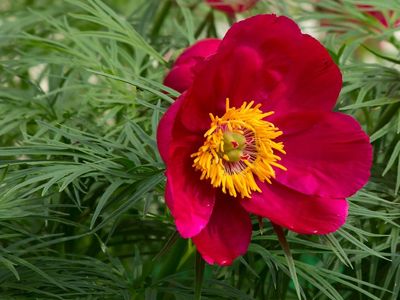Although fernleaf peony plants tend to cost a bit more, they’re worth the extra expense because they grow slowly and live so long.
How to Grow Fernleaf Peonies
Growing fernleaf peonies is easy in USDA plant hardiness zones 3-8. Peonies need cold winters and won’t bloom well without a period of chill. Fernleaf peony plants prefer at least six hours of sun per day. The soil should be fertile and well drained. If your soil is sandy or clay, mix in a generous amount of compost before planting. You can also add a handful of bone meal. If you’re planting more than one peony plant, allow 3 to 4 feet (1 m.) between each plant. Overcrowding can promote disease.
Fernleaf Peony Care
Water fernleaf peony plants every week, or more often when weather is hot and dry, or if you’re growing fernleaf peonies in container. Dig a handful of low nitrogen fertilizer into the soil around the plant when new growth is about 2 to 3 inches (5-7.5 cm.) tall in spring. Look for a product with an N-P-K ratio such as 5-10-10. Water well to prevent the fertilizer from burning the roots. Avoid high nitrogen fertilizers, which can cause weak stems and sparse blooming. Add a layer of mulch, about 2 to 4 inches (5-10 cm.), in spring to conserve soil moisture, then be sure to remove the mulch in fall. Add fresh mulch consisting of evergreen boughs or loose straw before winter. You may need to stake fernleaf peony plants, as the big blooms may cause the stems to lean towards the ground. Remove wilted flowers as they fade. Cut the stems down to the first strong leaf so the bare stems don’t stick up above the plant. Cut fernleaf peony plants nearly to the ground after the foliage dies down in fall. Don’t dig and divide fernleaf peonies. The plants don’t appreciate being disturbed, and they will grow in the same place for many years. Fernleaf peonies are rarely bothered by insets. Never spray ants crawling over the peonies. They are actually beneficial for the plant. Fernleaf peony plants are disease resistant, but they can be afflicted with phytophthora blight or botrytis blight, especially in wet conditions or poorly drained soil. To prevent infection, cut plants to the ground in early fall. Spray the shrubs with fungicide as soon as tips emerge in spring, then repeat every two weeks until midsummer.
